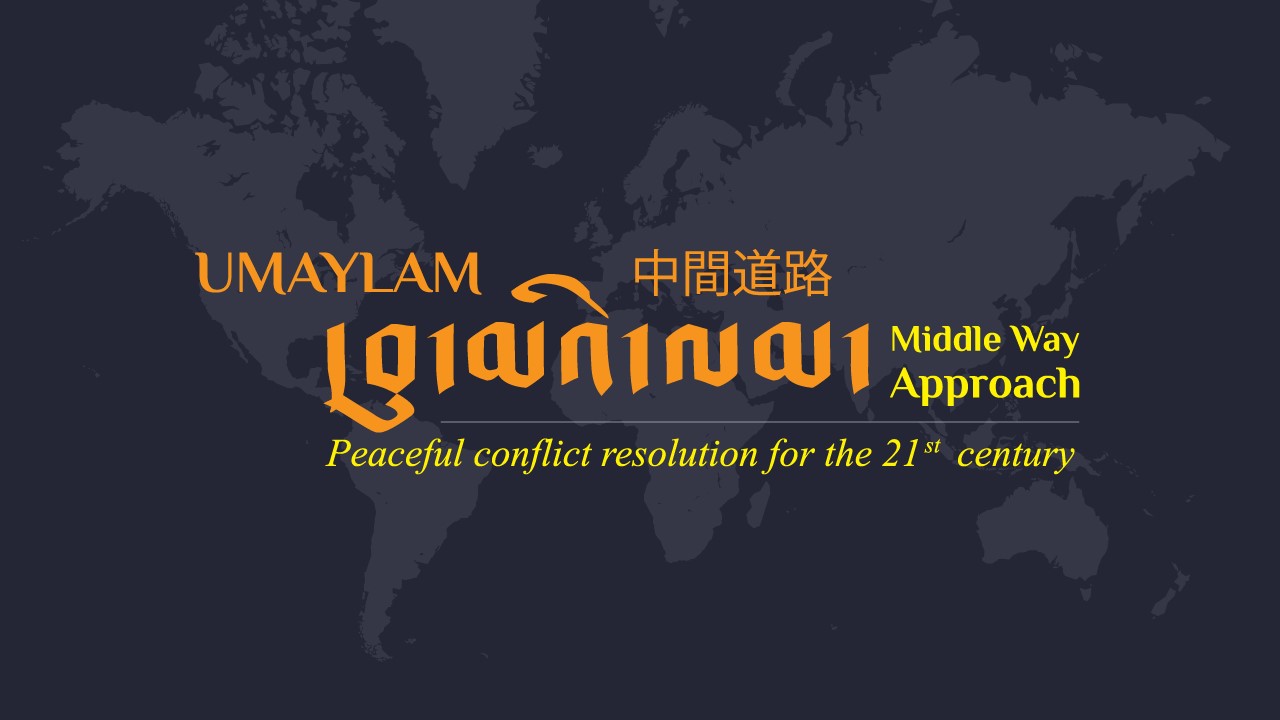One thing about the current situation I want to talk about is that I have decided to step on the path of the Middle Way Approach as the solution of resolving the Sino – Tibet problem. I also thought to speak about its origin and how the basic idea occurred. If I’m to explain the whole actual reasons, Tibet lost its freedom when I roughly reached the age of 15 or 16. The former incarnation (His Holiness the 13th Dalai Lama) took over the authority of Tibet’s political and religious power at the age of 18. It was my turn to take up the responsibility of Tibet’s political and religious authority at around 15 or 16 years old. That was the time when China started their invasion in Tibet. From the very day I took up the responsibility of Tibet’s political and religious power I’ve been walking on the way where both Tibet and China can reach a common ground and resolve the fundamental conflict between Tibet and China.
If we draw the line over Drichu(Yangtse river), these were complex issues since the beginning of 1950 when the first conflict took place in ‘dn-Khog,(འདན་ཁོག) around the end of spring or starting of summer, there’s no need to discuss it in details. I took up responsibility of Tibet’s political power around autumn of that year; At that time the “Mdo-spyi-ngo-las”(མདོ་སྤྱི་ངོ་ལས།) was already in the hands of the Chinese. Anyways there was no other method but to start a conversation with the Chinese (government). The best way was to negotiate. It is vital to gain knowledge of what the opposite side thinks. There would be no way of starting a conversation if not so. Lhasa sent off their representatives Sne-mgron Thub-bstan Legs-smon (སྣེ་མགྲོན་ཐུབ་བསྟན་ལེགས་སྨོན།) and Bsam-Pho-srsa Bstan-’dzin Don-grub (བསམ་ཕོ་སྲས་བསྟན་འཛིན་དོན་གྲུབ།) before I set off to Dromo. Dza-sag Khe-sme Bsod-Nams Dbang-’dus (ཛ་སག་ཁེ་སྨད་བསོད་ནམས་དབང་འདུས།) and Mkhn-drung Lha’u Rta-ra Thub-bstan Btsan-dar (མཁན་དྲུང་ལྷའུ་རྟ་ར་ཐུབ་བསྟན་བསྟན་དར།) were sent off after I arrived in Dromo. Nga-phod (ང་ཕོད།) had already arrived Beijing at that time. This is how the first conversations between Tibet and China happened around this time. Although we couldn’t get a satisfying negotiation as a country with its own authority and freedom, the negotiation files were settled with the intention of bringing maximal advantages under an abridged condition. This is the beginning of the very first step of what people in the west call “Compromise”, which is a way of negotiating with each other to try to reach an agreement. I was living in Dromo when the documents were being signed for the last agreement. I was ready to set off to India from Dromo if we went thoroughly on the way of revolt. We did not obtain a wholly satisfying negotiation under the condition, but there was no better way. It is like the saying “to meet with the fire when it burns you”. We returned to Lhasa from Dromo.
Although the situation got worse in the year of 1959, having conversation between Tibet and China was the very method pursued. Since there were no signs of the presence of Chinese (people) in the Lokha region when the first flee from Norbulinka took place, there was a plan to stay in Lokha and continue the negotiation with the Chinese military officials from Lhasa. We fled from Norbulinka to Lokha with this intention. The harsh military crackdown in Lhasa began when we arrived in Lokha and that led to no chance of continuing the conversation between us. After fleeing and seeking refuge in India there was no opportunity to engage in negotiations directly between us and China. During the cultural revolution, there was no chance of hearing any news about the conditions in the remote areas of Tibet but also Lhasa for a long period of time.
Then, in around 1973, the culture revolution continued in China, and Tibet was no exception. Tshe-dbang ‘phrin-las (ཚེ་དབང་འཕྲིན་ལས།) was the Deputy Speaker of the Tibetan Parliament-in-exile at that time. I cannot recall if he was the Speaker but I do clearly remember having conversation with him. The reason why this conversation took place was that it was only a matter of time that a conversation between Tibet and China would take place. We have no other options than to settle the conflict by negotiating from our side. Even if there was another way, it is vital for us to consider if that would be the right solution for us. There is no way of negotiating with only our side of desires. It is important to reach an agreement with mutual benefits; thus, it is important to expect how the dialogue with the Chinese should be conducted. We have the historical right to claim ourselves an independent country. The request of the Tibetan majority was also to free Tibet. From China’s side, they have absolutely no wish to hear words on Tibet being a free country; however, what they consider important is that it is crucial for Tibet to not be parted from China. Thus, keeping Tibet away from being parted from China is beneficial to China. On the other hand, it would be beneficial for us Tibetans too if an actual autonomy power with the three traditional provinces of Tibet in unity was guaranteed, if we can get the actual autonomy power with the three traditional provinces of Tibet in unity. But isn’t there some space to consider even if we can’t get the complete independence of Tibet? These were the discussions held in 1972 with the Bka’-blon (བཀའ་བློན།) and Speaker of the Tibetan Parliament-in-exile. Although there still wasn’t a super clear version of the future plan but the very fundamental thoughts of isn’t it better this way was already being prepared. My speeches after that have often been about “the reason why we fight is for happiness”. The Chinese (government) wouldn’t be pleased to hear about freeing Tibet, and many Tibetans wouldn’t be glad to hear the word autonomy out of the blue. This was the reason why I kept saying we need happiness. Our fundamental appeal is happiness, which is also the reality and truth.
Speaking from perspectives, for what reason are we appealing for freedom? And for what reason are we calling for autonomy? Both appeals are for the aim of happiness, rather than suffering. There could be an explanation made about this. According to the true situation, it was right to use this word (happiness), and this was how the very first steps of this plan were made in our minds.
In the end of 1978 and the start of 1979, the Chinese government reached out to Rgya-lo Don-grub (རྒྱ་ལོ་དོན་གྲུབ།) through a certain figure from Hong Kong for the first time. When it was discussed that a negotiation had to be made in between, the idea we had before in our mind that we should start a conversation with the Chinese (government) became the best option. The method of this conversation is what we call the Middle-Way Approach nowadays. Anyways, we had prepared the fundamental idea and principles in our minds around 1973 and in 1979 when China showed a straight forward move to reach out to us directly, we instantly expressed our will and pleasure to start the negotiation, and that’s how our representatives were planning to pay a visit.
From then until 1987 when we had direct connection with China, although we proposed a few articles from the Five Point Peace Plan, there wasn’t a clear conversation on Tibet transformed into a zone of peace and non-violence. At the same time, we proposed the Strasbourg Proposal and our main articles to the Chinese government, but China refused to admit in their official statements that there is a struggle inside Tibet. The actual struggle that needs to be resolved according to them is that the Dalai Lama and a certain number of Tibetans are still living outside the country. This was the problem they would like to resolve. According to them, there had been significant development made in Tibet and people were living happily and satisfactorily.
While meeting with Chinese governors in private, some of them like Yan-min-phu (ཡན་མིན་ཕུ།) and Ko’o-rud (ཀོའོ་རུད།), for example, did admit that there are issues in Tibet and that it is vital to solve these issues, and did admit that starting conversation with each other should be the resolution of resolving this struggle. However, they didn’t mean to take in whatever we suggested and discuss it jointly. At that time a democratic movement was getting larger inside China and the governmental policies of China seemed to be getting firmer. Thus in 1989 when I visited the USA, I finally started to speak clearly about the appeal of starting a negotiation between Tibet and China. It was easy for people who stand with us to support us when the appeal is clear. Happiness, on the other hand, was an abstract word that’s not distinct enough. So I thought it was a good idea to make it clear.
Since there was no genuine outcome from negotiating with China on one hand, on the other hand there was no other way then stating the appeal internationally, the Five Point Peace Plan was spread as a declaration. The fifth point of this plan was to continue the sessions between Tibet and China. The future direction of the Tibet-China connection should be based on an actual autonomy power with the three traditional provinces of Tibet in unity as the fundamental statement. These were discussed according to the legal text and handed in to the European parliament as a proposal in 1988. Before announcing it, if the Chinese government agrees with the fundamental statements of my Middle Way Approach, then the details of the document’s content shall be discussed. This is how we discussed these matters, and this is how the idea of the Middle-Way Approach evolved.


